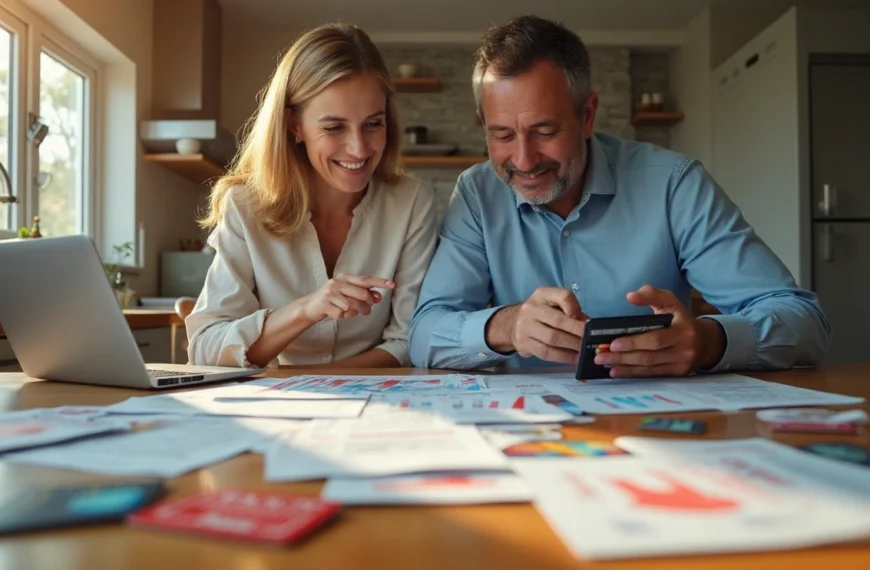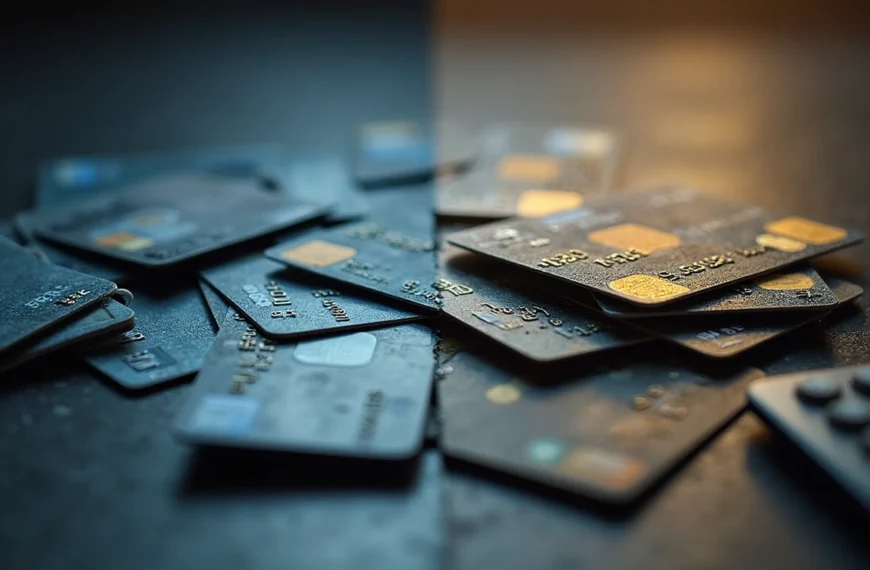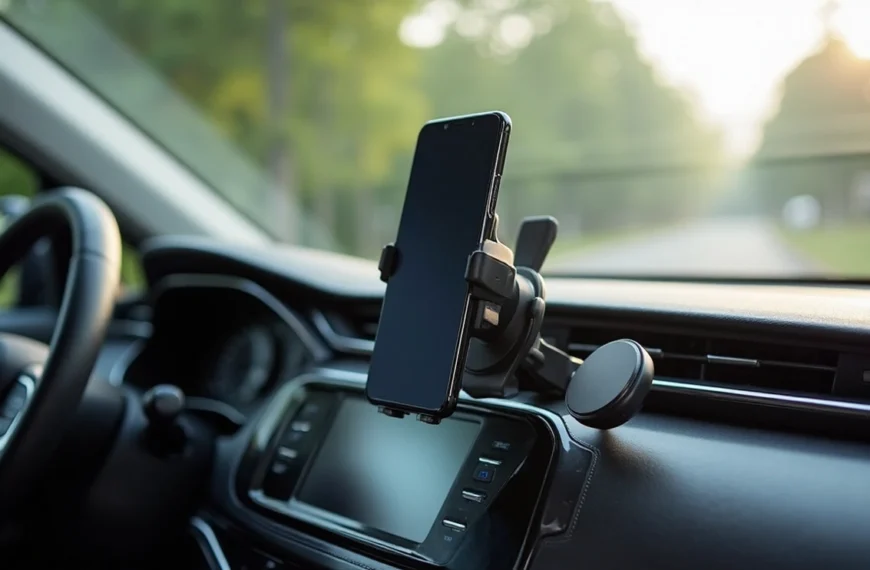Interest rates at 22-year highs make getting out of debt harder than ever for many Americans. Credit cards, auto loans, and personal loans won’t boost your net worth or future income. These items lose value quickly while you’re still stuck paying off the debt.
Debt can feel overwhelming even when you’re trying your best to stay afloat. The good news? People who complete Financial Peace University knock out $5,300 of debt in just 90 days. This shows you can crush your debt fast with the right game plan. Public Service Loan Forgiveness might look good on paper, but its tiny 2% approval rate means you’ll need better options.
A solid plan makes all the difference when you’re battling financial debt. Smart moves like building an emergency fund (experts say save 3-6 months of expenses) and picking the right payoff method like the debt snowball can set you up for success. Balance transfer cards with 0% intro APR for 12-18 months and debt consolidation might help too. Just watch out for debt settlement companies that take 15-20% of your total debt.
This piece shows you battle-tested ways to break free from debt and grab financial freedom – whatever your money situation looks like right now.
Stop the Debt Spiral Before It Grows
Image Source: FasterCapital
Smart financial habits help prevent debt from piling up. You can avoid the stress of watching debt spiral out of control by taking action now. Three strategies will protect you from mounting debt: smart budgeting, safety nets, and cutting costs you don’t need.
Create a realistic monthly budget
Your path to financial stability starts when you track every dollar you spend. People who can’t bounce back from money problems usually don’t have enough savings and end up using credit cards or loans, which makes everything worse. A budget shouldn’t feel like a prison—it should help you see your money clearly.
You should track all your spending for at least 30 days to learn where your money goes. Pick a budgeting method that works best for you. The 50/30/20 rule suggests you put 50% of your money toward needs, 30% toward wants, and 20% into savings and paying off debt. A zero-based budget will give a job to every dollar, which helps cut down impulse buys.
Build an emergency fund to avoid future debt
Think of an emergency fund as your shield against surprise expenses like fixing your car, medical bills, or losing your job. Without this safety net, even small money problems might force you to use credit cards and create new debt.
Money experts say you should save enough to cover three to six months of basic living costs. Starting small beats not starting at all. Put aside $500-$1,000 for minor emergencies, then build up from there. Research shows $2,467 is the “magic number” that helps people feel much more secure.
Set up automatic transfers from your checking to savings account on payday. Keep your emergency money in a high-yield savings account so it’s easy to access and grows a bit.
Cut unnecessary expenses and subscriptions
Subscription services can quietly drain your wallet. Last year, people wasted £688 million on subscriptions they didn’t use. Look through your bank statements, credit cards, and payment services to find recurring charges you might have forgotten.
Here are some common places to save money:
Streaming services and cloud storage (save up to $150+ yearly)
Gym memberships you don’t use (save $300+ yearly)
Multiple dating apps and meal kit services
Magazine subscriptions and premium software
Cutting costs doesn’t mean giving up everything you enjoy. Focus on the “big three” spending areas—housing, transportation, and food—where changes make the biggest difference. Small savings add up quickly; saving just $20 each week can reduce your debt by a lot over time.
Choose the Right Repayment Strategy
Image Source: Investopedia
Your choice of debt repayment strategy will determine how fast you can achieve financial freedom. A good budget and reduced expenses will free up money that you can use to pay off your debts.
Use the debt snowball method to win quick
The debt snowball method works on building confidence rather than pure math. You start by listing your debts from smallest to largest balance, whatever the interest rates. You make minimum payments on all debts and put any extra money toward your smallest balance. When you clear that debt, you add that payment to tackle your next smallest debt.
Small victories create momentum in this method. Studies from Northwestern’s Kellogg School found that “consumers who tackle small balances first clear their total debt more often” than those who focus on high-interest balances. A Harvard Business Review study showed that success comes not from the amount paid but from “what portion of the balance they succeed in paying off”.
The avalanche method saves you interest money
The debt avalanche method takes a different path by focusing on smart math. You target debts with the highest interest rates first, whatever their balance. You make minimum payments on all debts and put extra money toward your highest-interest debt until it’s gone, then move to the next highest.
This method cuts down your total interest over time. The avalanche approach could save you hundreds or thousands in interest, based on your debt mix. To cite an instance, calculations showed the avalanche method saved $153 in interest compared to the snowball method.
Find the method that works for you
The best strategy comes down to what drives you. Here’s what to think about:
Money matters: Pick avalanche if saving money is your main goal
Quick wins: Choose snowball if you need early victories to stay on track
Your debt mix: Both methods line up if your smallest debt has the highest interest rate
Both methods beat making just minimum payments, and you can switch between them if needed. The method matters less than sticking to your extra payments to clear your debt.
Explore Tools That Can Speed Up Repayment
Getting out of debt faster takes more than budgeting and picking repayment plans. Smart financial tools can speed up your debt payoff and cut those interest rates that keep people stuck in debt.
Think over a balance transfer card with 0% APR
Balance transfer cards are a great way to pause interest charges so your payments tackle the principal debt directly. These cards come with 0% APR deals lasting 12 to 21 months. This interest-free period helps you pay down debt quickly. Let’s say you move $6,371 to a card with an 18-month 0% intro APR – even with a 5% transfer fee, you’d save $1,111 compared to a card charging 21% APR.
The Wells Fargo Reflect® Card gives you 0% intro APR for 21 months on transfers made within 120 days. Another solid choice is the Citi Simplicity® Card that offers 0% intro APR for 21 months from opening on transfers done within four months.
Look into debt consolidation loans
These loans roll multiple debts into one fixed monthly payment at a lower rate than credit cards. You can borrow between $1,000 and $50,000, and take one to ten years to pay it back.
Here’s a real example: Moving $8,000 of credit card debt at 23% APR to a 5-year loan at 12% cuts your monthly payment by $40.33 and saves you $9,800 in interest. Your credit score should be 670 or higher to get the best rates.
Negotiate lower interest rates with creditors
You can save money by asking your credit card companies to lower your rates. Start with your oldest card or the one charging the highest interest. Tell them about your solid payment history, loyalty, and any recent credit score improvements.
They might say no to a permanent cut but agree to drop your rate 1-3 points for 6-12 months. Don’t give up easily – try again in a few months or mention better offers from other companies.
Use a debt management plan through a credit counselor
A Debt Management Plan (DMP) helps you pay off debt through a nonprofit credit counseling agency. Your counselor works to get lower rates, remove fees, and create a payment plan that works for you.
The agency collects one monthly payment from you and pays your creditors. While DMPs have setup fees around $33 and monthly fees near $25, the interest savings usually make up for these costs. People who finish these programs see their credit scores jump by 84 points on average.
Avoid Common Pitfalls and Stay on Track
A solid repayment plan won’t guarantee debt elimination success if you don’t avoid common mistakes. People with good intentions often fall into traps that can derail their progress and make their financial situation worse.
Be cautious of debt settlement companies
Debt settlement companies paint themselves as saviors for people drowning in debt. They promise to negotiate big reductions in what you owe. Notwithstanding that, this approach brings substantial risks. These companies usually tell you to stop paying creditors, which results in late fees, penalty interest, and more aggressive collection efforts. You also have no guarantee that creditors will even talk to these companies.
Watch out for debt settlement companies that:
Charge fees before settling your debts (legally prohibited)
Make promises about specific percentage reductions
Tell you to stop talking to creditors
Promise they can stop all collection calls and lawsuits
The Federal Trade Commission (FTC) strictly prohibits debt settlement companies from “charging fees before settling or reducing a customer’s credit card or other unsecured debt.” Report any company that asks for upfront fees to the FTC right away.
Don’t rely on personal loans to pay off debt
Personal loans can help combine debt under the right circumstances, but they’re not always the answer. Taking out a personal loan without a clear plan to pay it back puts you at risk. The loan just works like a temporary bandage if you keep building up debt and haven’t fixed your spending habits.
Personal loans often come with fees that can wipe out any interest savings. This happens especially when the interest rate difference between your credit card and the loan isn’t much. On top of that, using personal loans over and over to manage debt can trap you in an endless borrowing cycle.
Track your progress and celebrate small wins
Tracking your debt repayment trip works really well to stay motivated. The largest longitudinal study shows that breaking down goals into smaller, achievable chunks increases success rates by a lot. You can see your debt clearly to pick the best repayment strategy and stay motivated.
Small celebrations during your debt-free trip create psychological momentum. Reward yourself appropriately when you make a big payment or pay off a debt completely. A modest treat that doesn’t hurt your progress works well. You might want to use some of your debt snowball money for small rewards after hitting specific goals, like paying off each $1,000.
Conclusion
Taking Control of Your Financial Future
You need commitment, strategy, and patience to break free from financial obligations. Financial freedom becomes possible if you tackle both the mental and mathematical sides of paying off what you owe. This piece shows several proven ways to eliminate balances that work differently based on your situation.
The most important first step is to stop adding new financial burdens. A realistic budget, emergency fund, and cutting unnecessary expenses create a strong foundation to pay off outstanding amounts. These basic habits stop balances from growing and free up money to tackle existing bills.
Your motivation style determines whether the snowball or avalanche method works better. Quick wins from paying off smaller liabilities make the snowball method appealing. The avalanche approach saves more money on interest over time. Whatever method you choose, staying consistent leads to success.
Financial tools are a great way to eliminate what you owe faster. Zero-percent balance transfer cards, consolidation loans, talking to creditors, and repayment plans can lower your interest rates. These options help you reduce your financial commitments sooner. Each choice has its benefits and limits that need careful review.
Be careful with some relief solutions. Settlement companies often cause more harm than good, even with their tempting promises. Taking personal loans without changing spending habits just moves balances around. It helps to track progress and celebrate milestones along the way to becoming financially free.
Financial freedom is possible if you stick to these strategies. Even with large outstanding amounts, you can make real progress in months by staying organized and focused. The path to financial independence requires sacrifice and discipline, but the peace of mind and new opportunities make every step worthwhile.
You might also like: How to Get a Loan with Bad Credit in 2025: A Simple Step-by-Step Guide
FAQs
Q1. What’s the first step to getting out of financial strain quickly?
The first step is to create a realistic monthly budget. Track all your spending for at least 30 days to understand where your money goes, then choose a budgeting method that suits you, such as the 50/30/20 rule or a zero-based budget.
Q2. How can I choose between the snowball and avalanche repayment methods?
The choice depends on your personal motivation style. The snowball method focuses on paying off the smallest financial obligations first for quick wins, while the avalanche method targets high-interest balances to save more money over time. Consider which approach aligns better with your financial goals and psychological needs.
Q3. Are balance transfer cards a good option for managing outstanding balances?
Balance transfer cards can be an effective tool for repayment, offering 0% APR introductory periods typically ranging from 12 to 21 months. This interest-free window allows your entire payment to reduce the principal, potentially saving you significant money in interest charges.
Q4. How can I avoid common pitfalls when trying to become financially free?
Be cautious of settlement companies that make unrealistic promises or charge upfront fees. Don’t rely solely on personal loans to resolve financial obligations without addressing spending habits. Instead, focus on tracking your progress, celebrating small wins, and maintaining consistent effort in your chosen repayment strategy.
Q5. What role does an emergency fund play in financial recovery?
An emergency fund is crucial for avoiding future reliance on credit. It serves as a financial buffer against unexpected expenses, helping you stay on track without accumulating new liabilities. Aim to save three to six months’ worth of essential living expenses, starting with a modest goal of $500–$1,000 and gradually building from there.
References
[1] – https://consumerfinance.gov/an-essential-guide-to-building-an-emergency-fund/
[2] – https://afmorganlaw.com/top-10-strategies-to-manage-debt/
[3] – https://laist.com/news/cut-costs-pay-down-debt-save-money-new-year-2025
[4] – https://www.nationaldebtrelief.com/blog/financial-wellness/saving-and-investing/how-to-avoid-debt-essential-strategies-to-stay-debt-free-and-secure-your-financial-future/
[5] – https://dfpi.ca.gov/news/insights/three-steps-to-managing-and-getting-out-of-debt/
[6] – https://www.cnbc.com/select/how-to-build-emergency-fund-while-in-debt/
[7] – https://www.laurelroad.com/resources/how-to-build-an-emergency-fund/
[8] – https://www.thetimes.com/money-mentor/consumer-rights/how-to-cancel-subscriptions-and-save-a-fortune/
[9] – https://www.moneytalksnews.com/slideshows/stop-wasting-money-subscriptions-to-cancel-today/
[10] – https://www.experian.com/blogs/ask-experian/can-i-negotiate-a-lower-interest-rate-on-my-credit-card/
[11] – https://www.nfcc.org/resources/debt-management-plans/
[12] – https://www.investopedia.com/terms/s/snowball.asp
[13] – https://en.wikipedia.org/wiki/Debt_snowball_method
[14] – https://www.investopedia.com/terms/d/debt-avalanche.asp
[15] – https://www.cnbc.com/select/debt-snowball-vs-debt-avalanche/
[16] – https://www.bankrate.com/credit-cards/balance-transfer/best-balance-transfer-cards/
[17] – https://creditcards.wellsfargo.com/balance-transfer-credit-cards/
[18] – https://www.creditkarma.com/credit-cards/balance-transfer
[19] – https://www.bankrate.com/loans/personal-loans/how-debt-consolidation-loans-work/
[20] – https://www.equifax.com/personal/education/debt-management/articles/-/learn/what-is-debt-consolidation/
[21] – https://www.moneymanagement.org/debt-management














![No Win No Fee Lawyers: The Hidden Truth About Settlement Cuts Legal representation through no win no fee lawyers gives clients a way to fight cases without paying anything upfront. Many clients don't know that these services take a big chunk of money after winning the case. Lawyers usually take 25% to 40% of what you win as their contingency fee. The amount lawyers take from settlements can add up fast. A $100,000 settlement means your attorney gets $30,000 if they charge a 30% fee after winning your case. Your solicitor's cut might be £10,000 from a £30,000 compensation award, based on your agreement percentage. This payment model stays pretty much the same for no win no fee lawyers in different places, though percentages can change. This piece breaks down what you need to know about contingency fee deals. You'll learn about standard fee ranges, extra costs beyond the basic fee, and times when this payment setup might not work in your favor. Smart clients should think over these money matters before signing up with a lawyer to make better choices about their legal help. What No-Win No-Fee Really Means Image Source: Express Legal Funding A no-win no-fee arrangement, also called a Conditional Fee Agreement, changes the way people get legal help. This payment approach removes the need to pay legal fees upfront and creates a partnership between clients and their attorneys. How contingency fees work No-win no-fee agreements are based on contingency fees. Lawyers get paid only when they win compensation for their clients. Most lawyers take between 25% and 40% of the final amount, based on how complex the case is and where it's filed. Lawyers take their cut after winning the case. To name just one example, see a case where a lawyer wins £30,000 in compensation with a 33% fee - they would receive £10,000. On top of that, some law firms use sliding scales where they charge less for quick settlements and more if the case goes to trial. The law requires a written agreement before any work starts. This paperwork spells out the lawyer's percentage, what costs you'll need to cover, and other key details. What happens if you lose the case The meaning behind "no-win no-fee" is clear - losing your case means you won't pay your lawyer anything. All the same, you should know about a few money-related details. You won't owe your lawyer when you lose, but some deals might make you pay for court fees, expert witnesses, or other case expenses. The other side could also ask you to pay their legal costs. Many lawyers suggest getting "After Event" insurance to protect their clients. These policies cover any costs if you lose your case, which makes the no-win no-fee setup much safer. Why lawyers offer this model Lawyers want to make legal help available to more people, so they offer these payment plans. This setup helps people who don't have much money take legal action when they have valid claims. The payment structure motivates lawyers to work hard. They only get paid by winning cases, which pushes them to get the best results possible. Lawyers carefully assess each case before taking it on a no-win no-fee basis. They usually accept cases that have a good chance of winning, since they put in lots of time and resources without any guaranteed payment. The Real Cost: How Much Do Lawyers Take from a Settlement Image Source: Greiner Law Corp. The true cost of no-win no-fee legal representation becomes clear once we look at contingency fees. Many clients feel surprised to see a big chunk of their settlement checks going to their attorney's fees. Typical percentage ranges (25%–40%) No win no fee lawyers typically ask for 25% to 40% of the total settlement amount. Personal injury attorneys usually take 33.3% (one-third) of the awarded compensation[101]. Lawyers and clients agree on this percentage before any work starts on the case. Several factors shape the final percentage. Your chances of winning, case complexity, and the work to be done play key roles in determining the attorney's cut. Some areas have laws that cap the maximum contingency fees for specific types of cases. Sliding scale based on case complexity Law firms often use a tiered fee system that changes with the case stage and complexity. This scale rewards quick settlements while paying attorneys fairly if more work becomes needed. The fee might start at 30% if the case settles before lawsuit filing. This number could climb to 35% after filing or reach 40% if the case goes to trial. Law firms often group cases by complexity: 10%-20%: Simple cases with straightforward settlements 25%-35%: Typical personal injury cases 35% and above: Complex cases requiring extensive resources Examples of payout breakdowns These ground examples show how fees affect settlements: A $15,000 settlement with a 33.3% contingency fee.pdf) puts $5,000 in the attorney's pocket, leaving $10,000 for the client. Similarly, from a $100,000 settlement with a 33% fee, the attorney gets $33,000 while the client receives $67,000[102]. Complex cases tell a different story. A $100,000 settlement with a 30% fee plus $5,000 in extra costs leaves $65,000 for the client after all deductions. These fees substantially change the client's final payout. Hidden Costs You Might Not Expect Image Source: Nelson Personal Injury Lawyers Beyond percentage-based fees, clients often feel surprised by extra costs that can reduce their final compensation by a lot. These hidden costs show up in the fine print of no-win no-fee agreements. You should think over these details before signing. Court filing and expert witness fees Legal proceedings come with unavoidable court filing fees. These charges differ by jurisdiction. They usually range from $30 for small claims to several hundred dollars for complex civil lawsuits. Expert witnesses can be expensive, with hourly rates ranging from $150 to $1,000 based on their credentials and testimony complexity. Expert witnesses charge more for court appearances than consultation work because of added pressure and prep time. Clients might still need to pay experts for their prep work even if the case settles before trial. Medical report and investigation costs Medical documentation is a vital part of many legal claims. These costs include fees to release medical records, create specialized reports, and prepare documents. Investigation costs cover evidence gathering, police reports, witness interviews, and other fact-finding work needed to build a strong case. Of course, some firms say they'll cover these expenses upfront, but clients don't completely avoid these costs. When these costs are deducted from your compensation Law firms take these expenses from the settlement amount before they calculate their percentage fee, though each firm handles this differently. Some lawyers subtract these costs after figuring out their contingency fee, which changes how much money clients end up with. Most firms pay case-related costs during the process and get their money back from the settlement. The defendant usually pays most simple legal costs and disbursements in successful cases, but not always everything. Insurance protects clients from costs in unsuccessful claims at many law firms, but this protection isn't guaranteed. Clients should review their agreements carefully since they might still need to pay specific expenses even if they lose their case. When No-Win No-Fee Might Not Be the Best Option Contingency fee arrangements give many people access to justice. However, this payment model doesn't always work in a client's best interests. Knowing these limitations helps clients make better decisions about their legal representation. Cases with unclear liability Lawyer no win no fee arrangements work best in cases where fault is clear. We assessed the probability of success before taking contingency cases. Lawyers might turn down cases if there isn't enough evidence of the other party's negligence or if liability isn't certain. Cases with multiple responsible parties create more challenges. The situation gets complicated fast when several parties share liability. Lawyers are less likely to take these cases on contingency. They need to be confident they can prove the other party's negligence before accepting a case. Low-damage or low-payout claims Small claims often don't work well with the contingency model, even with real injuries. Cases that have minimal injuries or limited financial damages might not bring enough compensation to cover legal costs. The potential settlement needs to be big enough to pay for investigations, witness interviews and court fees. Personal injury lawyers often turn down cases where the "compensation potential" is too small. This doesn't mean the claim isn't valid - it just means the economics don't add up for a contingency arrangement. Situations where hourly billing may be better Hourly billing has clear advantages in certain cases. Clients see exactly what they're paying for - every hour worked and task completed. This model works well for cases that need lots of attention but don't have clear financial outcomes. Complex litigation with opposing parties works better with hourly billing and a retainer fee. Clients have more control over their case and don't feel pressured to settle quickly. Cases that need extensive preparation but have uncertain outcomes fit the hourly model better. Lawyers can spend the time needed without worrying about contingency limits. This approach often leads to better representation, especially for complex legal issues that need special expertise. Conclusion Understanding the Full Picture Before You Sign No-win no-fee arrangements offer legal representation without upfront costs. Of course, this seems attractive at first glance. In spite of that, you need to think about how these agreements can affect your final compensation. Legal fees usually range from 25% to 40% of your settlement - but that's just the start. You'll face more deductions like court filing fees, expert witness costs, and charges for medical documentation. What looks like a "free" service ends up taking a big chunk of your compensation to cover legal expenses. These arrangements work best in specific situations - cases with obvious liability, substantial damages, and solid evidence. If you have a low-value claim or complex liability issues, traditional hourly billing might serve you better. Without doubt, you should ask for clear explanations of all possible costs before signing anything. Read the fine print closely, especially when you have to deal with expenses in unsuccessful cases. Ask to see sample settlement breakdowns that show all deductions. This helps you picture what you might actually take home. Your choice to go with a no-win no-fee arrangement depends on your situation. This model helps if you don't have money to pursue valid claims. But if you have a strong case and enough funds, other fee structures might let you keep more of your compensation. Whatever payment model you choose, knowing exactly how much lawyers take from settlements helps you make better decisions. This knowledge lets you approach legal representation with real expectations and better control over your money. FAQs Q1. What percentage of a settlement do no-win no-fee lawyers typically take? No-win no-fee lawyers typically charge between 25% to 40% of the final settlement amount as their contingency fee. The exact percentage often depends on the complexity of the case and the stage at which it is resolved. Q2. Are there any hidden costs in no-win no-fee arrangements? Yes, there can be additional costs beyond the lawyer's percentage fee. These may include court filing fees, expert witness costs, medical report expenses, and investigation costs. These expenses are usually deducted from the settlement amount before or after the lawyer's fee is calculated. Q3. What happens if I lose my case in a no-win no-fee arrangement? If you lose your case, you generally won't have to pay your lawyer's fees. However, you might still be responsible for certain expenses like court costs or the opposing party's legal fees. Many lawyers offer insurance to protect clients from these potential costs in case of an unsuccessful claim. Q4. When might a no-win no-fee arrangement not be the best option? No-win no-fee arrangements may not be ideal for cases with unclear liability, low-value claims, or complex legal issues requiring extensive preparation. In these situations, traditional hourly billing might be more appropriate and potentially more cost-effective for the client. Q5. Can I negotiate the percentage a lawyer takes from my settlement? Yes, the contingency fee percentage is often negotiable. It's typically agreed upon and formalized in writing before the lawyer begins working on your case. Don't hesitate to discuss the fee structure with your lawyer and ask for a detailed breakdown of potential costs and deductions.](https://consumersweek.com/wp-content/uploads/2025/06/No-Win-No-Fee-Lawyers-The-Hidden-Truth-About-Settlement-Cuts-870x570.webp)


